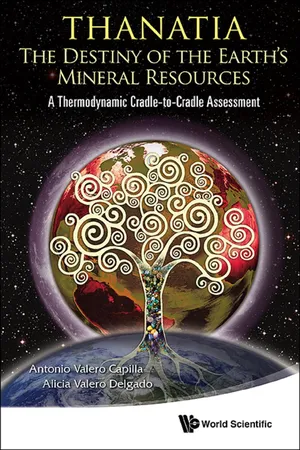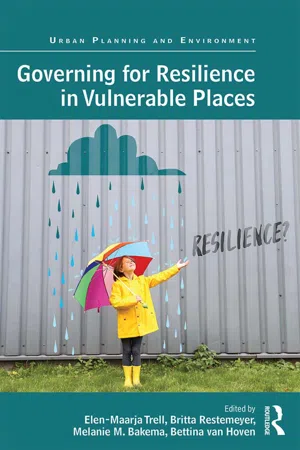Geography
New Energy Resources
New energy resources refer to alternative sources of energy that are being developed and utilized to reduce reliance on traditional fossil fuels. These resources include solar, wind, hydroelectric, geothermal, and biomass energy. They are considered more sustainable and environmentally friendly, and are increasingly being integrated into energy production to address concerns about climate change and energy security.
Written by Perlego with AI-assistance
Related key terms
2 Key excerpts on "New Energy Resources"
- eBook - ePub
Thanatia: The Destiny Of The Earth's Mineral Resources - A Thermodynamic Cradle-to-cradle Assessment
A Thermodynamic Cradle-to-Cradle Assessment
- Antonio Valero Capilla, Alicia Valero Delgado(Authors)
- 2014(Publication Date)
- WSPC(Publisher)
Chapter 6 The Resources of the Earth 6.1 IntroductionIn this chapter, a deeper look at the Earth’s components deemed useful to Man is undertaken. Consequently, a revision of energy and non-energy resources is carried out. This information will serve in a later chapter for assessing the exergy of the main resources on Earth. Energy resources have been divided into energy originating from the solid Earth i.e. nuclear and geothermal; tidal; and that derived from the sun, including solar, hydroelectricity, wind, biomass and hydrocarbons. After a general description of each, it shows all of the potentially available resources that Nature provides, those which could be effectively obtained using technology into the near future and those which are used today. In addition, mineral resources are studied, highlighting their abundance and average crustal concentration.6.2 Natural resources: definition, classification and early assessmentsA natural resource can be defined as any form of matter or energy obtained from the environment that meets a human need. Therefore water, air, oil, biomass or minerals are classified as such. Natural resources are frequently categorised as renewable or non-renewable. The former are defined as those that are regenerated within a human time scale. Examples include hydro, biomass or solar energy. On the contrary, the latter can be considered a stock that has a regeneration rate of zero over a relatively long period as is the case of minerals (Lujula, 2003).Minerals can be further classified as fuel and non-fuel resources. Fuel resources are those from which energy can be potentially extracted i.e. coal, oil, natural gas or uranium. Non-fuel minerals include metals and industrial minerals.An early assessment of the renewable and non-renewable energy resources on Earth was undertaken by Hall et al. (1987) and can be seen in Table 6.1 - eBook - ePub
- Elen-Maarja Trell, Britta Restemeyer, Melanie M. Bakema, Bettina van Hoven(Authors)
- 2017(Publication Date)
- Routledge(Publisher)
On the one hand, a spatial perspective can support the development of a more resilient energy system. Renewable energy production depends on local circumstances, ranging from climatic conditions, topography, economic investment opportunities and available social capital. Hence, taking a spatial perspective can assist in developing an energy system that, through adapting to diverse local circumstances, creates alternative development paths for regional energy systems. This will not only support the development and improvement of alternative technologies needed within the energy system but also allow for the exchange of energy between regions. For example, hydroelectricity or biomass can generate energy in one region to compensate for a lack of sun or wind due to weather conditions in another region.On the other hand, adapting renewable energy systems to local circumstances helps renewable energy to become embedded within a regions’ socio-economic fabric. The result is that renewable energy might well support existing economic activities such as agriculture, chemical industries, transportation or port activities. It can also create new economic pathways, generate jobs or support local liveability. The financial gains from energy production can be used for local investments in local services such as schools, mobility, housing or nature management. This could lead to renewable energy production becoming part of a strategy to improve a region’s resilience.The discussion below in section two focuses on how the shift towards a sustainable energy system urges us to discuss the relationship between the energy system and the physical and socio-economic landscape in which it is embedded. This discussion provides a background for the subsequent investigation. This investigation begins in section three with exploring the two interrelated challenges of the shift towards sustainable energy landscapes for spatial planning. In section four, the investigation continues by explaining how the notion of resilience can help us to better understand how spatial planners might respond to these challenges.Sections five and six contain the results of an empirical investigation into how the shift towards a more sustainable energy system might assist in creating both more resilient regions and a more resilient energy system. Data was gathered within the 2012–2015 MACREDES (‘MApping the Contextual conditions for Resilient Decentralised Energy Systems’) project that the author participated in. Within this interdisciplinary project, the author was part of a team studying the spatial dimensions of the shift towards an energy system based on more renewables. The research involved a study of multiple cases of locally based renewable energy initiatives, of (regional and national) research reports, of supervising and guiding master theses, several workshop sessions and over ten semi-structured interviews with government representatives. Although MACREDES provides important empirical insights for this chapter, it is important to note that this overall chapter takes a more theory-led perspective to explicitly argue and illustrate the relevance and possible use of a resilience perspective in pursuing a transition towards a more sustainable energy system. Finally, in section seven, a reflection will follow and some concluding remarks are presented.
Learn about this page
Index pages curate the most relevant extracts from our library of academic textbooks. They’ve been created using an in-house natural language model (NLM), each adding context and meaning to key research topics.

